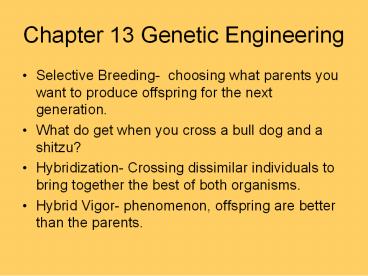Chapter 13 Genetic Engineering - PowerPoint PPT Presentation
1 / 21
Title:
Chapter 13 Genetic Engineering
Description:
Chapter 13 Genetic Engineering Selective Breeding- choosing what parents you want to produce offspring for the next generation. What do get when you cross a bull dog ... – PowerPoint PPT presentation
Number of Views:293
Avg rating:3.0/5.0
Title: Chapter 13 Genetic Engineering
1
Chapter 13 Genetic Engineering
- Selective Breeding- choosing what parents you
want to produce offspring for the next
generation. - What do get when you cross a bull dog and a
shitzu? - Hybridization- Crossing dissimilar individuals to
bring together the best of both organisms. - Hybrid Vigor- phenomenon, offspring are better
than the parents.
2
(No Transcript)
3
- Inbreeding is the continued breeding of
individuals with similar characteristics. - Risky, because it could bring out the recessive
alleles and cause a genetic defect. Blindness,
joint problems
4
Increase Variation
- Why would humans want to increase variations?
- Better the species
- Make the mutation occur faster
- More variety
5
- http//www.techapps.net/interactives/pepperMoths.s
wf
6
Manipulating DNA
- Scientist change DNA by
- Extracting DNA from cells
- Cut into smaller pieces
- Identify the sequence of bases on the DNA
molecule - Make unlimitied copies of DNA
7
DNA Extraction
- Cells are opened up and DNA is separated from
other parts of the cell
8
Cutting DNA
- DNA is cut into small fragments by restriction
enzymes. (Cuts DNA at a specific nucleotide
sequencevery precise)
9
(No Transcript)
10
Separating DNA
- Gel Electrophoresis- DNA Fragments are placed in
certain gel wells and an electric voltage is
passed through them. - DNA molecules move toward the opposite end of the
gel. - Smaller DNA fragments move faster through the gel.
11
(No Transcript)
12
Using the DNA Sequence
- The DNA Sequence can be read, studied, or
changed. - Compare genes with other organisms.
- Recombinant DNA- produced by combining DNA from
different sources.
13
(No Transcript)
14
Making Copies
- In order to study genes, it helps to make copies.
- PCR (Polymerase Chain Reaction)- makes many
copies of DNA through a process of heating and
cooling using DNA polymerase.
15
(No Transcript)
16
(No Transcript)
17
13.4 Applications of Genetic Engineering
- Transgenic Organisms- organisms contain genes
from other organisms. - Example The enzyme (luciferase) from fire flies
was transferred into a tobacco plant cell. - What do you think happens?
- The plant glows at darkpage 331
18
Why make transgenic organisms?
- Resist pests, herbicides, harsh conditions
- Improve nutritional value, shelf life
- Test and study
- Medical purposesinsulin, growth hormone,
clotting factors - Transgenic Animals can produce more milk, less
fat, human proteins
19
Cloning
- Cloning is producing genetically identical cells
from a single cell. - Bacteria is easy to clone (unicellular)
- What about multicellular organisms?
- Ian Wilmut cloned the first sheep. DOLLY.
20
Cloning Process
21
To Clone or Not to Clone?































